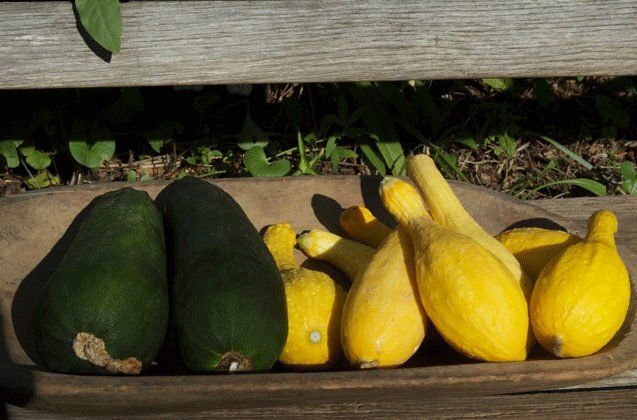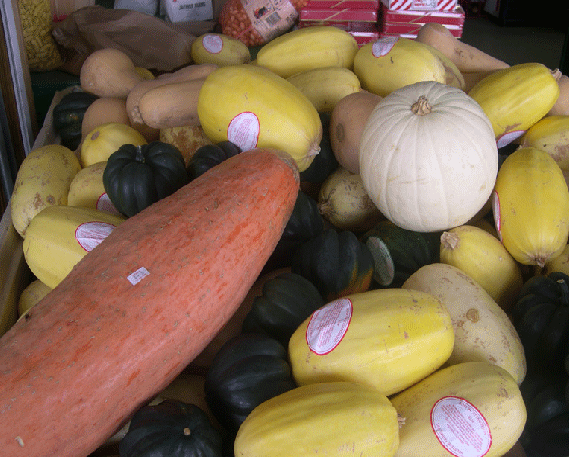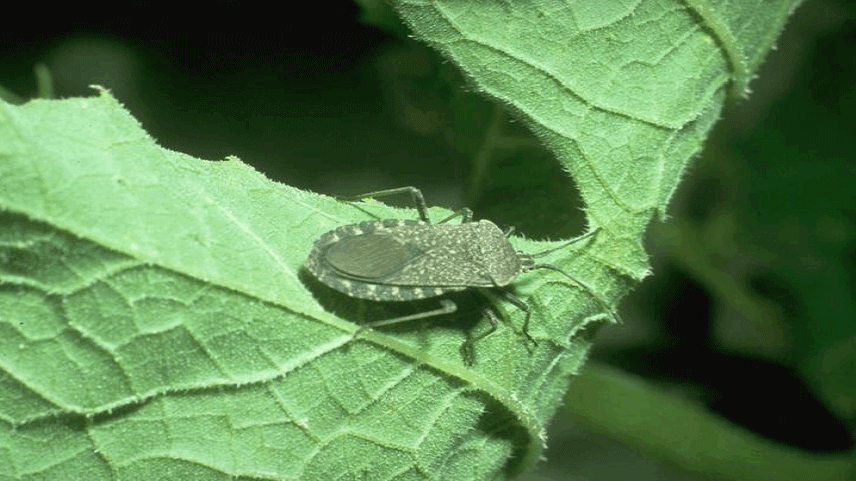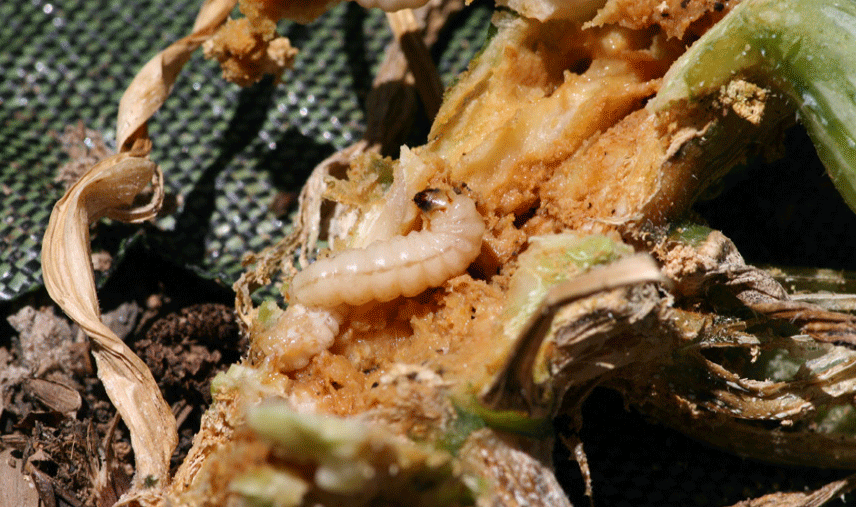- Types
- Soil Preparation
- Culture
- Fertilization
- Harvesting, Storing, and Using
- Problems
- Insects
- Disease
It is difficult to imagine summer without summer squash casserole or winter without winter squash soup. Both types of squash are very nutritious, have high fiber content and are high in vitamins A and C. Squash are not difficult to grow, so anyone who likes to garden can enjoy them first in the garden and then on the table.
Types
Summer squash grows on nonvining bushes. The three main types include: the yellow straight neck or crooked neck, the white scallop or patty pan, and the oblong, green, gray or gold zucchini.
Winter squash matures on the vine and is covered with a hard rind that permits winter storage. It is categorized according to its fruit size: small fruits (1 to 4 pounds) include acorn types, butternut types, and some true winter squash types; intermediate fruits (6 to 12 pounds) include banana squash, Cushow, Hubbard and some Sweet Meat varieties; large fruits (15 to 40 pounds) include Blue Hubbard, Boston Marrow and Jumbo Pink Banana varieties; jumbo fruits (50 to 100+ pounds) include Big Max and various Mammoth varieties.
 Photo 1: Summer Squash
Photo 1: Summer Squash Photo 2: Winter Squash
Photo 2: Winter SquashSoil Preparation
All squash prefer organic, rich, well-drained soils. Organic matter will help increase uptake of water and nutrients. Adding compost or aged manure will give plants a good start. New garden sites should be amended with at least 4 to 5 inches of good organic matter and then tilled 8 to 10 inches into the native soil. The ideal soil should be slightly acidic (between a pH of 5.8 and 6.8) with a soil temperature range of 65 to 80 degrees Fahrenheit.
Culture
Plant summer squash in full sun after danger of frost is past. Plant four to six summer squash seeds in individual mounds 4 feet apart. After they have two leaves, thin to two to three plants per mound. Transplants can also be used. Make sure they have two to three mature leaves and a well-developed root system. Winter squash, because of its vining nature, needs more room. Allow 6 to 8 feet between mounds for plants to spread out. Winter squash requires warm soils and can be planted a few weeks after summer squash has been sowed.
After the plant seeds have germinated, apply some type of organic mulch. Grass clippings, straw and newspapers help to control weeds, conserve water and keep the fruits clean. Newly seeded gardens should be watered daily and lightly for the first week to ensure good germination. Established squash will require between 1 to 1½ inches of irrigation per week. Using drip irrigation or soaker hoses is the most efficient and healthy way to water plants. Moisture needs to penetrate 6 to 8 inches deep into the soil. Avoid wetting the foliage since doing so can lead to disease. Reduce watering once the fruits ripen to avoid fruit rot.
Squash has both male and female flowers and needs bees or other insects for pollination. If insect activity is low, female flowers are likely to drop. To avoid this, you can pollinate them yourself. Use a cotton swab to gather pollen from the male flower and distribute it onto the stigma in the center of the female flower. (Female flowers have a small ovary or swelling behind short-stemmed flowers. The male flowers are larger and have longer and thinner stems).
Fertilization
Fertilization of squash should begin at planting time. Get a soil test to find the most accurate fertilizer recommendations. In the absence of a soil test, apply 3 tablespoons of 5-10-15 fertilizer per planting mound at planting time. After the squash plants begin to flower and small fruits form, side-dress with additional fertilizer according to the soil test recommendations. Organic fertilizers can also be substituted to provide the nutritional needs of the plants. After fertilizing, be sure to water the plants thoroughly to help release the nutrients.
Harvesting, Storing, and Using
It takes 35 to 45 days for summer squash to mature. Summer squash should be harvested at a young stage for the best flavor. The optimal size is 4 to 6 inches long and 1½ inches in diameter. Generally, summer squash is harvested every other day. The sooner you begin harvesting, the sooner new squash is formed. Store summer squash at 45 to 55 degrees F for two to four days. Summer squash can be cooked, sautéed and used in casseroles and soups. Zucchini is often used shredded in breads, raw in salads or as a party dip. Summer squash does not freeze well.
Winter squash takes 80 to 120 days to mature. It is mature when fruits are fully colored, vines are starting to die back, and the rind is hard and resistant to scratches with fingernails. Matured fruits should be harvested with the stem attached and stored in a cool (50 to 55 degrees F), dark and dry location. Buttercup and banana squash store longer than butternut and acorn squash. Winter squash can be baked, steamed, simmered or mashed. Winter squash does freeze well (peel, cut into cubes and remove seeds; cook covered in water until soft; mash it and pack into containers leaving a 2-inch headspace; it will keep about a year).
Problems
Several serious insects, diseases and environmental factors attack summer and winter squash plants.
Insects
Aphids – Aphids are small insects found on new stems and on the underside of leaves. Leaves become yellow, crinkled and curled. The insects suck fluids from the plant, leaving a honey dew substance behind. To control, use insecticidal soaps or a strong stream of water to dislodge insects.
Squash Bugs – Squash bug adults are gray or brown and suck the sap from leaves, leaving them speckled before they wither and die. The bugs must be controlled while they are immature. To control, pick the bugs by hand or use insecticides.
Squash Vine Borer – Squash vine borer is a troublesome pest that begins as an adult that lays eggs in the lower stems of squash plants. Developing larvae tunnel and eat their way to the lower stems, causing plants to wilt and eventually die. Control is difficult, and prevention with a labeled insecticide is the key. If the insect is detected early, it can be carefully cut out with a sharp knife. Soil should then be mounded over the wound to encourage rooting.
 Photo 3: Squash Bug
Photo 3: Squash Bug Photo 4: Squash Vine Borer
Photo 4: Squash Vine BorerDisease
Powdery Mildew – Powdery mildew is a white powdery substance that appears on older leaves. It eventually spreads to all parts of the plant. Use surface or underground watering methods to avoid wetting leaves, and/or plant resistant varieties.
Blossom-end rot – Blossom-end rot affects fruits. Fruits develop a black-rot on the end. Hot weather and lack of calcium, as well as a lack of moisture, increases susceptibility. To control, supply even moisture to the plant and supply lime as needed.
Photos by Malgorzata Florkowska, J. B. Robinson and Caley Anderson
Status and Revision History
Published on Nov 04, 2010
Published with Full Review on Nov 04, 2013
Published with Full Review on Aug 01, 2016
Published with Full Review on Aug 05, 2021


























































